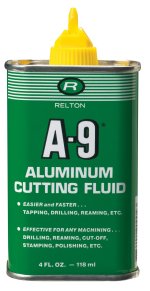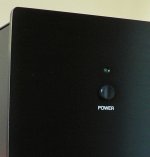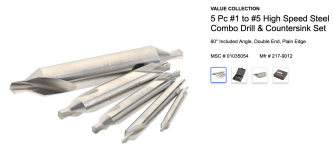I recommend acetone as a lubricant for aluminium. Also resting the alu on a hard surface when drilling produces cleaner holes, particular on the far side.
Acetone? Too flamable surely - cutting agents should either be non-flam or burn with a visible flame so you notice before its too late. Also solvent abuse...
Acetone is not only „highly flammable“ (correct term?), it’s also a nerve agent.
IPA works quite good even though it’s good for a new haircut too…
IPA works quite good even though it’s good for a new haircut too…
Thin plate or sheet aluminum works 100% fine without cutting fluid. With sharp tools, you're not in it long enough to produce much heat.
I work mild steel at less than 1/4" without oil/CF usually even with HSS tooling. Stainless is another story. Marvel Mystery oil is just mineral oil with an added solvent and works well in steel or aluminum but may be improved for Al use with a bit more solvent to thin it. Mineral spirits.
I work mild steel at less than 1/4" without oil/CF usually even with HSS tooling. Stainless is another story. Marvel Mystery oil is just mineral oil with an added solvent and works well in steel or aluminum but may be improved for Al use with a bit more solvent to thin it. Mineral spirits.
I second the suggestion for "Noga" style deburring tools. They cut only as much as you want them to, and are factory-sharpened quite well so that the risk of accidentally gouging due to use of high force is fairly low.
Another alternative that you may want to evaluate is to put a conical sanding bit ("abrasive cone") in a tool holder or chuck extension and simply hand-spin until the desired amount of material removal is done.
I don't personally recommend the use of multi-flute chamfering tools. I have a 5-flute version that is still fairly sharp but only seems to be able to mush material into the hole unless very high axial force is applied.
Another alternative that you may want to evaluate is to put a conical sanding bit ("abrasive cone") in a tool holder or chuck extension and simply hand-spin until the desired amount of material removal is done.
I don't personally recommend the use of multi-flute chamfering tools. I have a 5-flute version that is still fairly sharp but only seems to be able to mush material into the hole unless very high axial force is applied.
Burrs are largely tearing of the aluminum itself. Sharp bits that are well lubed leave fewer if any burrs. Drill through onto a sacrificial hard wood surface moving it on every hole to get a fresh surface helps on blow through on the back side. A softer surface won’t prevent the aluminum from pushing out instead of cutting. Another idea is to make a sandwich of a sacrificial layer of aluminum on each side of the workpiece clamped tightly together. The workpiece in the middle will be burr and blowout free. It’s wasteful but it does give great results.
I just tried to googling "best practice hole aluminum" and among the dozens of results on the front page and some of them seem not to have been mentioned yet in this thread, except the fact of lubricating the drill bit.
Assuming I'm not wrong, as I can't remember every word said on this thread, let it be clear that I don't say the above to absolutely despise of course, but only that's what seems to appear googling.
It seems that aluminum has a low melting point and therefore three elements, in addition to the already mentioned lubrication of the cutting point, stood out from the research and are the following:
1. A cobalt drill bit, since it seems to dissipate heat better;
2. A tip (in cobalt) with an angle of 118° instead of 135°, since a 118 degree bit has a sharper point;
3. A drill press choosing a medium speed, again due to the fact that aluminum has a low melting point.
No idea if the above is true as it seems, but as said it's what comes from the first page when googling it, assuming I haven't missed anything else.
Assuming I'm not wrong, as I can't remember every word said on this thread, let it be clear that I don't say the above to absolutely despise of course, but only that's what seems to appear googling.
It seems that aluminum has a low melting point and therefore three elements, in addition to the already mentioned lubrication of the cutting point, stood out from the research and are the following:
1. A cobalt drill bit, since it seems to dissipate heat better;
2. A tip (in cobalt) with an angle of 118° instead of 135°, since a 118 degree bit has a sharper point;
3. A drill press choosing a medium speed, again due to the fact that aluminum has a low melting point.
No idea if the above is true as it seems, but as said it's what comes from the first page when googling it, assuming I haven't missed anything else.
Once deburred you can get rid if the silver around the holes by applying a permanent black marker to these surfaces and rub off any excess on the anodised surface. You might notice it on close inspection but further back it blends in. Just needs a marker that matches the sheen of the panel.
Attachments
there are many flavours of aluminium, some are much better to machine than others. the worst drill like in butter and create bad edges.
so first choose a machineable alumimium. then use drilss for alimunium , they are different than for steel, with a much larger top angle, so the point looks flatter. choose cobalt type drills if the alu is fighting back.
so first choose a machineable alumimium. then use drilss for alimunium , they are different than for steel, with a much larger top angle, so the point looks flatter. choose cobalt type drills if the alu is fighting back.
Sometimes you can't choose and then you've just aluminum plate that you've, and it's difficult to determine its flavour if not after you've machined it.
Yes, there are many variables in the materials, tools, equipment and process.
Two that you can control are the "feeds and speeds", or in this case, the RPM of the drill bit and how fast you try to push it through the work piece.
If you still get bad results with a sharp bit and good cutting fluid, then try reducing the speed and/or feed rate - just slow down.
In my experience, these are commonly misunderstood and overlooked.
Two that you can control are the "feeds and speeds", or in this case, the RPM of the drill bit and how fast you try to push it through the work piece.
If you still get bad results with a sharp bit and good cutting fluid, then try reducing the speed and/or feed rate - just slow down.
In my experience, these are commonly misunderstood and overlooked.
Basically there's pure Al, unworkable basically, then there are the precipitation-hardening alloys, of which there are many kinds, but all machine much better than pure Al which is soft and claggy and develops massive burrs. The huge variety of alloys is about trading various properties like corrosion resistance, weldability, speed of hardening, usable temperature range and such like, they mechanically behave pretty similarly.there are many flavours of aluminium, some are much better to machine than others. the worst drill like in butter and create bad edges.
so first choose a machineable alumimium.
I remember when DIY hang gliders changed from bamboo to aluminum tubing; it was bewildering to see "6061-T6" and "2024-T3" and other arcane & inscrutable hieroglyphics, printed in the parts list for a stupid weekend toy which merely glides down a sloped beach at Torrey Pines.
I also find it funny how 6061-T6 is now "military grade". It used to be "aircraft grade" in the various marketing blurbs.
But getting back to de-burring: I favour something that can be spun using a drill press and the workpiece touched to it. At least I get really consistent results with that. The last thing you want is some uneven de-burring that then needs to get cleaned up. The de-burring tools shown in post #37 work well if you have to de-burr by hand.
Acetone as a cutting fluid?? For real? Why? That sounds like a health and fire hazard if there ever was one. I've never heard of acetone being a nerve agent and the MSDS says there isn't sufficient evidence to say one way or the other. But other solvents are known to cause brain issues, so it seems likely. Acetone is known to cause liver and kidney damage, but I think you have to drink it for that to happen.
My main concern with acetone would be its flammability (or inflammability for those who are language geeks). It's quite volatile and will happily help you burn your house to the ground.
I much prefer A-9 Aluminum Cutting Fluid. Not to be confused with A-1 steak sauce 🙂. A-9 behaves much more like an oil and its fumes won't wreck your brain or internal organs. You can find it at industrial supply houses. I bought my small can of it at Tacoma Screw some 15ish years ago.

Tom
But getting back to de-burring: I favour something that can be spun using a drill press and the workpiece touched to it. At least I get really consistent results with that. The last thing you want is some uneven de-burring that then needs to get cleaned up. The de-burring tools shown in post #37 work well if you have to de-burr by hand.
Acetone as a cutting fluid?? For real? Why? That sounds like a health and fire hazard if there ever was one. I've never heard of acetone being a nerve agent and the MSDS says there isn't sufficient evidence to say one way or the other. But other solvents are known to cause brain issues, so it seems likely. Acetone is known to cause liver and kidney damage, but I think you have to drink it for that to happen.
My main concern with acetone would be its flammability (or inflammability for those who are language geeks). It's quite volatile and will happily help you burn your house to the ground.
I much prefer A-9 Aluminum Cutting Fluid. Not to be confused with A-1 steak sauce 🙂. A-9 behaves much more like an oil and its fumes won't wreck your brain or internal organs. You can find it at industrial supply houses. I bought my small can of it at Tacoma Screw some 15ish years ago.

Tom
A machinist would use a countersink, slow speed. Set the work piece on a piece of wood. Slow speed...

Set the depth stop...A machinist would use a countersink, slow speed. Set the work piece on a piece of wood. Slow speed...
Tom
Get a set of Center Drills and have bonus deburring with the included 60 degree chamfer:
https://www.mscdirect.com/product/details/01035054
https://www.mscdirect.com/product/details/01035054
Attachments
First of all Congrats on drilling those holes- I have tried it and failed massively...you are a pro!
For deburr, I have used a large drill bit or countersink...but gently and by hand. Depending on the size of the burrs you may or may not see any adverse effects.
Good advice here, wish I knew all this back in the day!
For deburr, I have used a large drill bit or countersink...but gently and by hand. Depending on the size of the burrs you may or may not see any adverse effects.
Good advice here, wish I knew all this back in the day!
Bear in mind some tables give ideal cutting speeds in feet or meters per minute, you have to calculate the ideal rpm for your bit size using the circumference.
And get center drills, they are a handy item for many jobs, particularly for pilot and starter holes.
And get center drills, they are a handy item for many jobs, particularly for pilot and starter holes.
- Home
- Design & Build
- Construction Tips
- How to deburr holes in Aluminium without creating a countersunk drilling?

